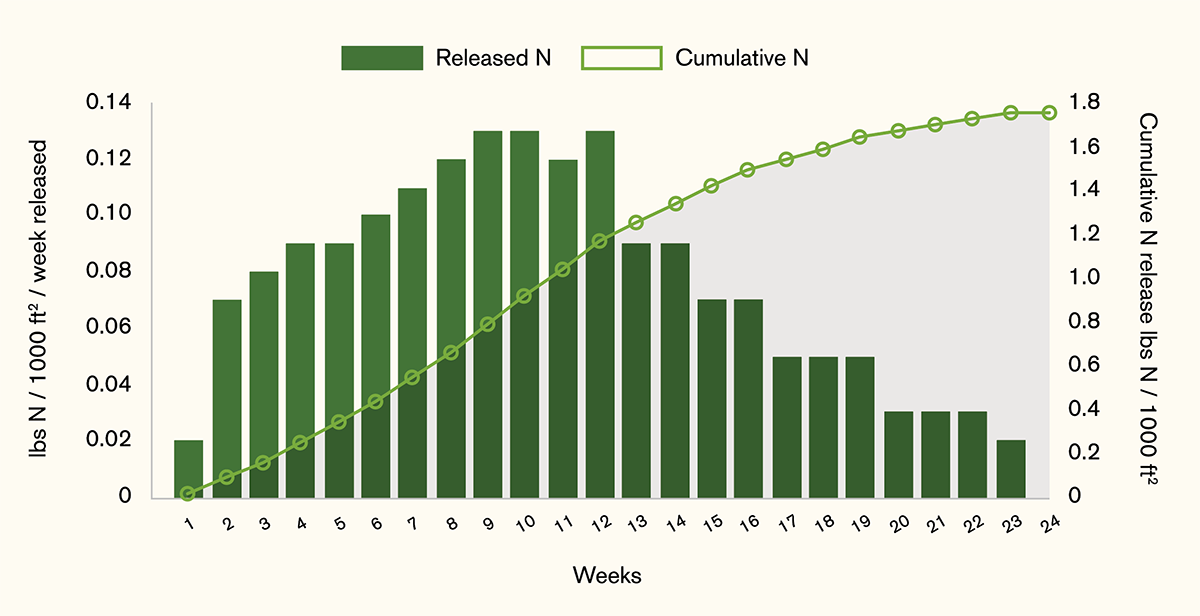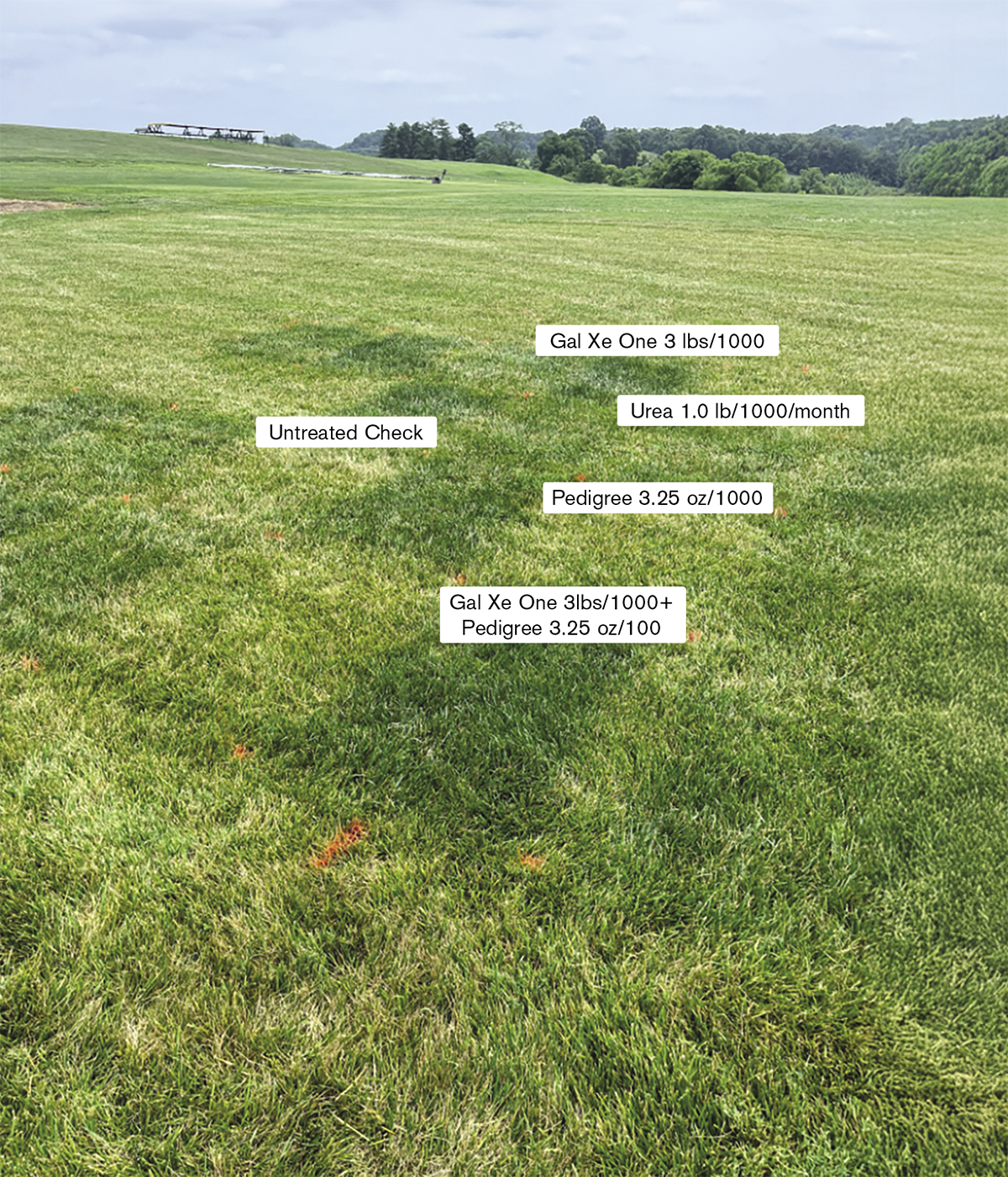
7 minute read
Cover Story
New Thinking: How Should Fertility be Used to Manage Brown Patch Disease in Tall Fescue Lawns?
By Dr. Brandon Horvath, Professor, Turfgrass Pathologist, UT Plant Sciences
Tall fescue is a prominent lawn grass choice especially in the Middle and Eastern Tennessee regions where cool-season turfgrasses are more prevalently used. Brown patch, caused by Rhizoctonia solani, is the most damaging pathogen affecting tall fescue lawns throughout Tennessee. This fungal disease can transform a lush, vibrant lawn into a patchy, unsightly expanse when conditions favor disease development.
While fungicide applications are often necessary for severe outbreaks, proper fertility management serves as the foundation of an effective preventative strategy. Fertility practices directly influence plant health, disease susceptibility, and recovery potential. Unfortunately, many common fertilization practices can actually make the problem worse. Supported by several years of research findings, we have recently employed a different approach that maintains some growth turfgrass potential via fertility that enables infected plants to recover following disease pressure. Understanding the relationship between fertility inputs and disease development will allow lawn care professionals to implement proactive management programs that reduce disease severity while maintaining a quality turfgrass stand. This article explains how different fertility approaches affect brown patch in tall fescue lawns and provides practical ideas for turfgrass managers to implement these approaches in a lawn care setting.
Understanding Brown Patch Disease
Pathogen Biology and Life Cycle
Rhizoctonia solani is a soilborne fungal pathogen that is present in most turfgrass environments. The fungus survives unfavorable periods as mycelia in thatch and soil. Under specific environmental conditions, primarily with high temperature and humidity, the fungus becomes active and begins to attack the plant.
In tall fescue, R. solani primarily infects the leaf blades and sheaths, creating lesions that eventually result in a circular “patch” appearance. The fungus spreads via mycelial growth, moving from plant to plant through direct contact (Figure 1). Unlike other turfgrass diseases, brown patch does not spread via spores.

Environmental Triggers in Tennessee
Tennessee’s climate creates ideal conditions for brown patch development during much of the main growing season. The Brown Patch pathogen becomes active in response to:
Temperature thresholds: Nighttime temperatures that consistently remain above 65°F with daytime temperatures between 80–85°F. These conditions typically develop in TN from midMay through September, sometimes persisting into October.
Humidity factors: Relative humidity that exceeds 80% greatly increases infection rates. Our humid summer climate, especially during nighttime, will frequently exceed this threshold.
Leaf wetness: Extended leaf wetness periods of 10+ hours dramatically increases infection rates. Evening irrigation practices, frequent summer thunderstorms, and morning dew are common in Tennessee and contribute to this risk factor.
So, it is under these conditions that the plant becomes most susceptible to fungal attack and infection. Historically, conditions coincide with timing of when recommendations suggest backing off on fertility applications to allow the plant to “harden off”. However, our work has shown that a plant that is not able to actively recover will be in a worse position as multiple rounds of disease take place and decimate the stand.
Nitrogen Management and Brown Patch Susceptibility
Nitrogen is the most important nutrient for proper turfgrass growth, and there is a direct and significant impact on nitrogen management with brown patch susceptibility in tall fescue. Traditionally, research has shown that water-soluble, quick-release nitrogen sources (such as urea, ammonium sulfate, and ammonium nitrate) significantly increase brown patch severity compared to slow-release formulations. The main reason for this effect has been that at higher doses, the plant grows more rapidly, resulting in a thinner cuticle and lush, succulent growth. Modern practices, however, allow for much lower application rates of N fertility, and a spoon-feeding approach can often improve turfgrass performance.
Using controlled-release nitrogen sources like polymer-coated urea will deliver nitrogen more gradually (Figure 2), which in turn will reduce disease-prone succulent growth while maintaining adequate plant growth for recovery. This relationship is really the key to using fertility to help manage the damage caused by brown patch. Ideally, the turfgrass manager wants the plant to grow just enough that when conditions aren’t conducive for disease, the plant will grow out of the symptoms and recovery will take place. When that condition exists, the turfgrass plants will be capable that when exposed to another disease cycle, some damage will occur, yet recovery will again take place.

Application Rate and Timing
Under-fertilizing a turfgrass stand or lawn is much more common today than over-fertilizing. As long as the applicator avoids excessive nitrogen application during high-risk periods, one of the most common fertility mistakes that often leads to more severe brown patch outbreaks can be avoided. By providing the plant with “just enough” fertility, the need for plant growth can be balanced with not overstimulating the pathogen’s ability to attack. I began to change my own perspectives on these recommendations about a decade ago, when some of our research clearly demonstrated that having moderate fertility applied during the growing season led to lower brown patch severity and also a decrease in undesirable competition from bermudagrass encroachment. As a result, I began making some adjustments in my recommendations on fertility:
Late Spring (April-May): Limit applications to 0.5-0.75 lb N/1000 sq ft using primarily slow-release sources as temperatures begin to approach the brown patch threshold. Alternatively, one could use a very slow-release poly coat urea, that would provide ~3 lbs N/1000 sq ft for the April-August Period (~20 wks)
Summer (June-August): Make low rate applications (0.1-0.2 lbs N/1000 sq ft; ~0.6-1.2 lbs N/1000 total for 3 months) during the highest risk brown patch season. These applications are made to just maintain some turfgrass growth and recovery potential without sparking lush succulent growth. Slowrelease sources can also be used.
Early Fall (September): Use fertilization at 0.75-1.0 lb N/1000 sq ft as temperatures moderate to focus on turfgrass recovery from summer stress and disease pressure.
Late Fall (October-November): Apply 1.0-1.5 lb N/1000 sq ft, emphasizing root development and carbohydrate storage.
In total, here in Tennessee, managers should target about 4-5 lbs of N/1000 sq ft/year for a quality Tall Fescue lawn. Making these slight adjustments in how we fertilize will help reduce the damage caused by disease while allowing for turfgrass recovery throughout the season, maintaining turf quality.

Conclusion
Effective brown patch management in tall fescue lawns requires an “allhands” approach centered around proper fertility practices. By understanding the relationship between nutrition and disease development, lawn care professionals can significantly reduce brown patch severity while maintaining acceptable turf quality.
Key takeaways include:
1. Timing is critical: Avoid quick release, high rate, nitrogen applications during high-risk periods (June-August in Tennessee)
2. Source matters: Use slow-release sources to smooth out N release over time mimicking a low rate “spoon feeding” approach
3. Integrate approaches: Coordinate fertility with appropriate cultural practices and if needed, fungicide interventions
4. Prevention focus: Implement proactive programs rather than reactive treatments
Using these research-based fertility practices, I’m confident that turfgrass and grounds managers can significantly reduce the impact of brown patch in client and home landscapes while promoting healthier, more resilient tall fescue lawns.





